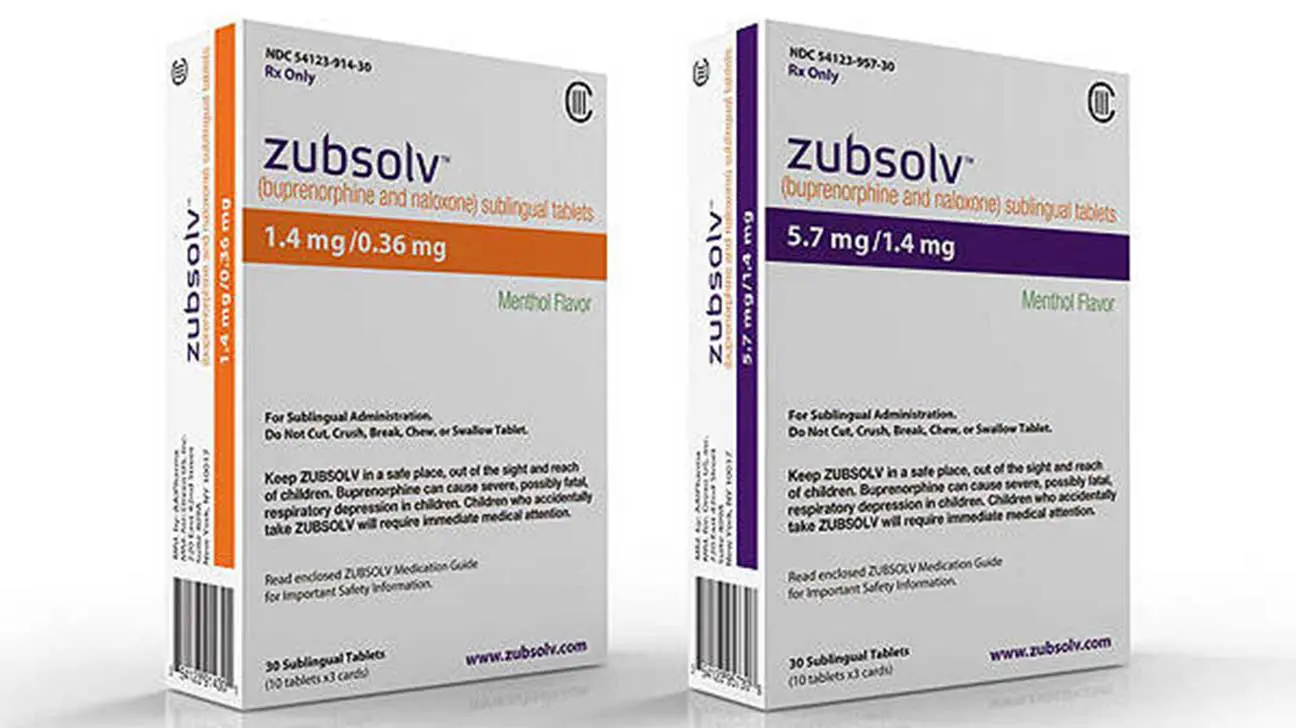
Zubsolv is an opioid medication used to treat those with opioid use disorders. It comes as a small sublingual tablet (CIII) containing buprenorphine and naloxone.
Zubsolv can treat drug addictions that include both illicit substances and prescription drugs.
Learn more about the benefits of taking buprenorphine for opioid addiction
How Zubsolv Works
The two active ingredients in Zubsolv are buprenorphine and naloxone. Zubsolv treatment works best as a part of a larger treatment plan that utilizes behavioral therapies.
Zubsolv Is An Opioid Blocker
Buprenorphine is a partial agonist that treats the painful symptoms of opioid withdrawal. It works by binding to opioid receptors in the brain and fulfilling the cravings for opioids.
Naloxone is an opioid antagonist that also binds to the opioid receptors in the brain. This medication serves to block and reverse the harmful effects of opioids.
Together, buprenorphine and naloxone treat withdrawal from opioid drugs and block the effects of opioids.
If a person uses a full opioid agonist such as oxycodone while taking Zubsolv, they won’t feel any euphoria.
Read more about how Zubsolv blocks opiates
How Long Does Zubsolv Block Opiates?
The combination of buprenorphine and naloxone will block opiates for at least 24 hours and up to 60 hours.
The length of time Zubsolv blocks opiates depends on the size of the last dose. A larger dose will take effect for longer, but a smaller dose will wear off more quickly.
Is Zubsolv A Narcotic?
Zubsolv is considered a narcotic drug. One of the active ingredients, buprenorphine, is a narcotic.
As a narcotic, this medication has the potential to lead to abuse and physical dependence.
Types Of Zubsolv
There is currently only one available form of Zubsolv, the brand-name version. Zubsolv does not come in a generic form.
Administering Zubsolv
Zubsolv is a sublingual tablet, which means it’s meant to be taken under the tongue.
To take Zubsolv, place one tablet under the tongue and let it fully dissolve before eating or drinking anything.
If your doctor has prescribed a second tablet, take them both at the same time by placing them on different sides under the tongue.
Read more about how to properly take Zubsolv
Zubsolv Vs. Suboxone
Both Zubsolv and Suboxone contain a combination of buprenorphine and naloxone.
Zubsolv was approved by the U.S. Food & Drug Administration (FDA) because it was so similar to Suboxone.
While both medications contain the same ingredients, Suboxone comes in a sublingual film or strip, and Zubsolv only comes in a tablet form.
Different Doses
Zubsolv and Suboxone have different doses for treating opioid dependence. Currently, there is a wider range of doses offered with Zubsolv.
Doses offered for Zubsolv:
- 0.7 mg of buprenorphine and 0.18 mg of naloxone
- 1.4 mg/0.36 mg
- 2.9 mg/ 0.71 mg
- 5.7 mg/ 1.4 mg
- 8.6 mg/ 2.1 mg
- 11.4 mg/ 2.9 mg
Doses offered for Suboxone:
- 2 mg/ 0.5 mg
- 4 mg/ 1 mg
- 8 mg/ 2 mg
- 12 mg/ 3 mg
Zubsolv Has A Higher Potency
There is greater bioavailability with Zubsolv, making it more potent than Suboxone.
This means it will likely take a smaller dose of Zubsolv to achieve the same results as a higher dose of Suboxone.
Generic Vs Brand Name Availability
Zubsolv does not come in a generic form, but Suboxone does. The generic name for Suboxone is buprenorphine and naloxone.
Zubsolv Dosing
Zubsolv comes in six different dosage strengths ranging from 0.7 mg/ 0.18 mg of buprenorphine/naloxone to 11.4 mg/ 2.9 mg.
The average daily dose of Zubsolv is between 2.9 mg/0.71 mg and 17.2 mg/4.2 mg. The target dose is 11.4 mg/2.9 mg once daily for maintenance treatment.
Side Effects Of Zubsolv
According to the medication guide for Zubsolv, a few of the most common side effects include:
- headaches
- sweating
- drug withdrawal
- runny nose
- constipation
- pain
The medication can also cause life-threatening breathing problems or a severe allergic reaction.
If you feel faint, dizzy, or your breathing slows, call your healthcare provider right away and get emergency help.
Read more about the side effects of Zubsolv
Effects On Weight
One of the most common side effects of Zubsolv is swelling of the extremities, which can cause rapid weight gain.
Learn more about whether Zubsolv will make you gain weight.
Read more about potential weight gain from taking Zubsolv
Troubles Sleeping
Zubsolv has been found to cause both insomnia and drowsiness in some patients.
Nausea Or Stomach Issues
You may feel very nauseous or have abdominal pain while using Zubsolv. These side effects are both common and usually very mild.
Effects On Your Hair
Zubsolv is not known to cause any negative impacts on hair.
Read more about the effects of Zubsolv on hair
Feelings Of Anxiety
Anxiety is not a common side effect of Zubsolv, but it does happen in some patients.
However, anxiety is much more likely to occur if the substance is misused (such as injecting Zubsolv) and a person goes through withdrawal.
Effects On Blood Pressure
Using Zubsolv can cause an increase in blood pressure in the brain and biliary tract, which can cause liver problems and issues with the gallbladder.
If you have had any serious head injuries or brain damage, Zubsolv may cause a dangerous increase of pressure inside the head.
If you have an allergic reaction to Zubsolv, you may experience very low blood pressure.
Neonatal Opioid Withdrawal Syndrome
If a pregnant woman uses Zubsolv throughout the pregnancy, it is possible for the baby to experience withdrawal after he or she has been born.
The opioids can be transferred via the bloodstream while in the womb as well as through breast milk if a woman is breastfeeding.
Abuse Of Zubsolv
Zubsolv is a Schedule III controlled substance that has the potential for abuse.
It is possible to get high off Zubsolv when it’s taken in larger quantities or misused. Abuse of Zubsolv can result in overdose and death.
Read more about getting high on Zubsolv
Dangerous Drug Interactions
If you’re currently taking any other prescription or over-the-counter medications, seek the medical advice of your doctor before starting Zubsolv.
CNS Depressants
Serious complications can arise if a person takes Zubsolv with benzodiazepines (benzos), alcohol, or any other central nervous system (CNS) depressants.
Mixing Zubsolv and benzos can cause respiratory depression, coma, or death.
Serotonergic Drugs
Using Zubsolv with drugs that stimulate serotonin receptors (such as antidepressants) can cause a life-threatening condition called serotonin syndrome.
Important Safety Information About Zubsolv
Zubsolv is a powerful opioid drug and should be kept out of the reach of children.
This medication is not to be used on an “as needed” basis. It’s meant to be taken once daily to treat chronic pain, and only as the prescribing doctor has directed.
The Street Price Of Zubsolv
Zubsolv usually goes for about $10 per mg/ 2 mg tablet of Zubsolv.
More common is Suboxone, which can cost $5 to $10 for an 8 mg/ 2 mg tablet. This is nearly equivalent to the 8.6 mg/ 2.1 mg Zubsolv tablet, and both sell for similar prices.
For comparison, the street price of buprenorphine alone is about $3.95 per mg.
Read more about the street value of Zubsolv
What If I Miss A Dose Of Zubsolv?
In the case of a missed dose, just take your Zubsolv dose when you remember it. If it’s close to the time that you usually take Zubsolv, wait and take it at your scheduled time.
It’s best to take Zubsolv at the same time each day, but if you miss a dose it will still be effective and you should not experience any symptoms of withdrawal.
Find Zubsolv For Opioid Addiction Treatment
While it’s important to treat the physical symptoms of withdrawal, Zubsolv is most effective when it’s used as a part of a treatment program that treats the whole person.
With an addiction treatment program, a person recovering from opioid addiction can participate in both medical and behavioral therapies to address mental health in recovery.
Choose from programs such as medication-assisted treatment (MAT), outpatient rehab, or inpatient rehab.
There are options available for you or your loved one to recover from drug abuse.
Call our helpline today to get started and learn more about how Zubsolv can help in the treatment of opioid dependence.
Addiction Resource aims to provide only the most current, accurate information in regards to addiction and addiction treatment, which means we only reference the most credible sources available.
These include peer-reviewed journals, government entities and academic institutions, and leaders in addiction healthcare and advocacy. Learn more about how we safeguard our content by viewing our editorial policy.
- Connecticut State Department of Consumer Protection—Buprenorphine and Naloxone Combination
https://portal.ct.gov/DCP/Drug-Control-Division/Drug-Control/Buprenorphine-and-Naloxone-Combination - Medical News Today—Zubsolv (buprenorphine/naloxone)
https://www.medicalnewstoday.com/articles/326633#:~:text=Zubsolv%20is%20taken%20by%20placing,your%20tongue%20at%20one%20time. - National Institute on Drug Abuse (NIDA)—Opioid Overdose Reversal with Naloxone (Narcan, Evzio)
https://www.drugabuse.gov/drug-topics/opioids/opioid-overdose-reversal-naloxone-narcan-evzio - U.S. Food & Drug Administration—FDA approves first generic versions of Suboxone sublingual film, which may increase access to treatment for opioid dependence
https://www.fda.gov/news-events/press-announcements/fda-approves-first-generic-versions-suboxone-sublingual-film-which-may-increase-access-treatment - U.S. National Library of Medicine: PubMed—Leveraging black-market street buprenorphine pricing to increase capacity to treat opioid addiction, 2010-2018
https://pubmed.ncbi.nlm.nih.gov/32353575/ - Psychiatric Research Institute—What is Buprenorphine?
https://psychiatry.uams.edu/clinical-care/cast/buprenorphine/ - Zubsolv—Dosing to clinical effectiveness
https://www.zubsolv.com/healthcareprofessionals/about-zubsolv/administration-dosing/ - Zubsolv—Important Safety Information
https://www.zubsolv.com/healthcareprofessionals/important-safety-information/ - Zubsolv—Medication Guide
https://www.zubsolv.com/medicationguide


